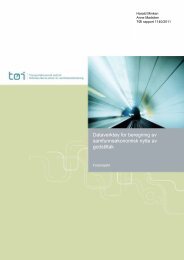Trafikkopplæring i Danmark 'fra vugge til rat' - Transportøkonomisk ...
Trafikkopplæring i Danmark 'fra vugge til rat' - Transportøkonomisk ...
Trafikkopplæring i Danmark 'fra vugge til rat' - Transportøkonomisk ...
Create successful ePaper yourself
Turn your PDF publications into a flip-book with our unique Google optimized e-Paper software.
Traffic education in Denmark: ‘From cradle to wheel’<br />
be comprised by a given GDL-program. Based on this summary, the following<br />
conclusions can be stated:<br />
Age of debut: Increasing the age of debut as a car driver with one year in the interval<br />
16-21 years reduces the driver’s accident risk of the first year of driving by 5-10 %.<br />
The effect is decreasing with increasing age. The risk decrease for each single age<br />
level is not statistically significant, but is probably nevertheless real because all<br />
estimates go in the same direction and because the tendency has been found in every<br />
study that is comprised by the calculation of accident risk.<br />
Slippery-surface training increases the number of accidents for drivers who have gone<br />
through courses of driving on slippery surface. This finding is consistent for all<br />
groups of drivers having attended such courses. The increase in the number of<br />
accidents are lowest among personal car drivers (12 %) and highest among drivers of<br />
heavy vehicles (22 %) and both are statistically significant.<br />
Driving-in-darkness training seems generally to increase the number of accidents among<br />
novice drivers by 11 %, which is statistically significant.<br />
Problem drivers: Training problem drivers to drive defensively is commonly used in the<br />
USA and in other countries which have demerit point systems. Defensive driving<br />
courses for problem drivers reduce the number of accidents by 5-10%. This outcome<br />
is documented by experiments and should be regarded as a methodological well<br />
funded finding.<br />
Basic/formal driver training: The best studies are designed as experiments were the<br />
drivers are randomly distributed to formal and non-formal driver training. When<br />
controlling for the number of kilometers driven, drivers with formal driver training<br />
have 11 % (+ 8%; +15%) more accidents pr km compared to drivers without formal<br />
driver training.<br />
Outcome of number of driving lessons: Some of the studies that have evaluated the<br />
outcome of formal driver training also stated the number of training hours. These<br />
studies showed that the number of accidents pr km driven increased with the<br />
number of training hours. This finding is also based on experiments with random<br />
assignment to test- and control-group.<br />
Supervised, private driver training: In 1993, Sweden lowered the age limit for driver<br />
training from 17,5 to 16 years. The reform allowed novice drivers to be supervised by<br />
a lay person when driving. The lay person has to be 25 years or older and having held<br />
a driving license for more than 5 years. After establishing the 16-year reform, formal<br />
driver training at an authorized driving school increased with 8 %, while supervised,<br />
private driver training increased with 100 %. As a consequence the risk of being<br />
involved in a personal injury accident was reduced from 0.98 to 0.81 pr million km<br />
driving, i.e. a reduction of 17 % (p< 0.05).<br />
Effects of curfew laws: A curfew law making night-time driving illegal within specific<br />
limits of time, reduces the all-day number of accidents with 7 % (p > 0.05), while the<br />
effect within the time-limits of the curfew is a 36 % reduction in the number of<br />
personal injury accidents (p < 0.05).<br />
Effects of graduate driver licensing (GDL): The best estimate of the effect of graduated<br />
driver licensing is a 19 % reduction in the number of all accidents (unspecified level<br />
of injury). For personal injury accidents the reduction is 6 %, fatal accidents 26 %,<br />
night-time accidents 31 %, and single accidents 21 % (all p < 0.05). For drink-driving<br />
Copyright © Institute of Transport Economics, 2012 V







